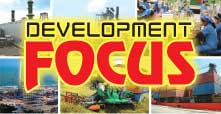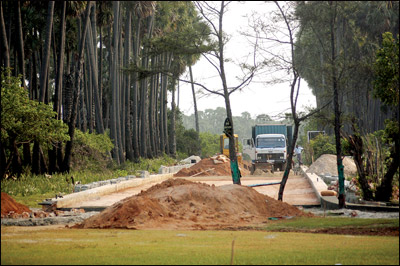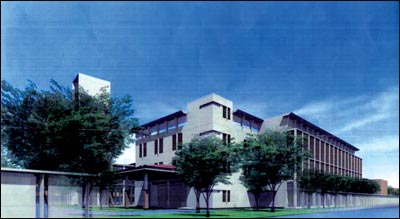Jaffna reawakening
Massive development drive:
Irangika RANGE in Jaffna
 During the four-year tenure of President Mahinda Rajapaksa, a new
era was heralded in the North opening new vistas for its future
prosperity through his policy document Mahinda Chinthanaya.
During the four-year tenure of President Mahinda Rajapaksa, a new
era was heralded in the North opening new vistas for its future
prosperity through his policy document Mahinda Chinthanaya.
The development of the North's economic and social infrastructure
was expedited to a level that the country had never witnessed, under
the Uthuru Vasanthaya which had provided significant infrastructure
facilities to the people in the North whose lives were wrecked by
the LTTE during the past three decades.
|

Brisk business in Jaffna town |
The herculean task of giving a new lease of life to the North is
being executed under the Presidential Special Task Force on
Rehabilitation and Resettlement headed by Senior Presidential
Advisor Basil Rajapaksa MP, who toured the region to observe the
work in progress to expedite the clearing of mines to facilitate
resettlement of families and provide all facilities to farmers who
are trying to restart their normal livelihoods after the total
eradication of terrorism.
According to Northern Province Governor Major General G.A.
Chandrasiri, a number of new and large infrastructure projects such
as ports, roads, power projects, water projects, hotels, apartment
development, religious places infrastructure development, hospitals
and schools are nearing completion while many development have
already been completed at regional level in the entire Jaffna
peninsula.
The Government has taken measures to fully realize the inherent
potential of the Jaffna people for the benefit of all inhabitants in
the district.
Development in the Jaffna district was lagging behind for the
past 30 years due to the war, but it began to develop rapidly since
President Mahinda Rajapaksa prioritized its development projects
through his national policy.
|

Guru Nagar fishing harbour. Pictures Sudam Gunasinghe |
On this occasion, the Government has been able to implement the
aspirations and objectives embodied in the Mahinda Chintana policies
to benefit the people living in Jaffna under the "Uthuru Wasanthaya
180 days development program". In comparison to the other districts
during this past four years, the rapid development activities in the
Jaffna district has become a focal point in Sri Lanka.
Today, Jaffna is reawakening with a massive development drive
which has contributed largely to boost the Jaffna economy enabling
the people who were displaced as a result of brutal LTTE terrorism
for nearly three decades to recommence their normal livelihood in a
peaceful and free environment.
Jaffna at a glance
Jaffna district is the Northern end of the Northern Province of
Sri Lanka, about 410 km away from Colombo. It consists of the
peninsula and seven inhabited Islands. The North, East and West
boundaries of the district are the Indian Ocean. On the South is the
Jaffna Lagoon and Killinochchi District. The total land area
including inland waters is 1,025 sq. kms. Jaffna District is divided
into four Sub Divisions. They are Islands of Vallikamam,
Thenmaradchi and Vadamaradchi. The land in Jaffna district could be
characterized as flat with less than five degree inclination . There
are over 631 ponds and 2,433 ditches scattered all over the district
with connected channels to conserve rain water. Excess water easily
drained into the sea and the lagoon. The levels are Point Pedro
15.24m, Myliddy 10.8m. Chankanai 3.04m and Kokuvil 6.09m above Sea
level. Jaffna district falls under the dry zone. Peak rainfall is
during the months of October to December during North East Monsoon
and scattered during April to May.
|

Cultivation of an abandoned paddy field |
According to the 1981 census the population of the district was
831,800 (Including Kilinochchi district which was part of Jaffna
District in 1981) and based on the natural growth rate, it is
projected that the population of Jaffna district would be more than
1,000,000 in 2005. But the population as at April 2007 is only
650,720. The difference between the projected population and the
present population may be due to the following reasons. Migration
out of the district and to foreign countries. The family size is
reduced due to frequent displacements of the family members on
account of the unsettled conditions. Displacement outside the
district and decline in natural growth trend.
Jaffna district is divided into 15 administrative divisions such
as Delft, Islands South, Islands North, Karainagar, Jaffna, Nallur,
Valikamam South West, Valikamam West, Valikamam South, Valikamam
North, Valikamam East, Thenmaradchi, Vadamaradchi South West,
Vadamaradchi North and Vadamaradchi East. There are 435 Grama Sevaka
Officers divisions in this district. Seventeen local bodies
including Municipal Council in Jaffna, Urban Councils in
Chavakachcheri, Point Pedro and Velvettithurai and 13 Pradeshiya
Shabhas in Delft, Islands South, Islands North, Nallur, Valikamam
South West, Valikamam West, Valikamam North, Valikamam East,
Chavakachcheri, Vadamaradchi South West , Point Pedro and Krainagar
are functioning in the Jaffna district.
Agriculture and Irrigation
Jaffna district is predominantly an agricultural area and always
has been an area with high potential in agriculture. Crops such as
red onion, chillies, potatoes, tobacco, vegetables, banana and
grapes are cultivated for commercial purposes. Other crops such as
paddy, pulses, coconut cultivation in subsistences level, palmyrah
products also a subsistence source of income. About 65,400 families
and 30,000 farm labourers are involved in agriculture and livestock
in the district. In addition a large share of the population is
engaged in home gardens. Paddy is cultivated in 8,068 hectares and
other field crops are also cultivated in Jaffna district. About
19,261 agro wells and 2,433 ditches are being used for agricultural
purposes.
|

Renovation of causeway to Karainagar |
Paddy is produced during the Maha season under the rain-fed
conditions while vegetables are produced nearly all year around
under rain-fed or irrigated conditions. Mainly ground water
resources are being used for agricultural purposes. There are two
lagoons in Jaffna District. One is Vadamarachchi and the other is
Upparu lagoon.
According to the statistics in 2008, Chili, red onion, potatoes,
kurakkan, green grams, black grams, cowpea, ground nut, gingerly,
tobacco, manioc, betel, beetroot and other vegetable have cultivated
in hectares of 340, 550, 19, 97, 87, 54, 37, 13, 693, 766, 306, 51,
927 respectively for Maha season while the production of these items
were 589mt, 5315mt, 143mt, 78mt, 43mt, 37mt, 18mt, 4mt, 224mt, 2,442
mt, 4,127 mt, 657mt and 6,485 mt respectively had yield for the Maha
season. The average annual milk production is 11,022, 270 litters in
the Jaffna district in 2008.
Jaffna as a whole has experienced much progress in varied spheres
in the aftermath of war. This has not been confined to one single
area, but has reached even the remotest of all areas in the
district.
The Government has allocated Rs.2695 million for the development
in the Jaffna district last year. Massive development projects in
the fields of transport, health, education, human resettlement,
agriculture and transport have been undertaken by the Government
under the Uthuru Wsanthaya" program in the Jaffna district are in
progress.
|

Construction of access to Kasurina beach |
The road sector has given priority for the development in the
Jaffna district under the Uthuru Vasanthaya. Accordingly, 11 roads
including Meesalai-Varany road, approach road to Pungudutivu
hospital, Sangarathai tank road, Mirusuvil-Usan-Ketpali road,
Chulipuram-Paralai road, Palavoddai-Oori road,
Kachchi-Ketpeli-Elephant Pass road, Erlalai-Kadduwan road,
Kondavali-Irupalai road, Allaipiddy road and Allaippiddy-Mankumpan
road had rehabilitated at a cost of Rs. 43 million.
Fifty buses under minor repairs and 66 buses with major repairs
in the depots of Nallur, Point Pedro and Karainagar have
rehabilitated while fuel pump test bench in Jaffna depot and
installation of fuel tank at Karainagar depot has been undertaken at
a cost of Rs. 36 million.
Jaffna University
Construction of three wards and reconstruction of ambulance
garage in Ayurvedic Hospital in Chavakachcheri has taken place at a
cost of Rs.17 million.
Twenty three school buildings in schools in Velanai, Jaffna,
Nallur, Kopay, Chavakachcheri, Karaveddy, Point Pedro, Sandilipay,
Tellippalai have constructed at a cost of Rs.100 million.
Meanwhile, the Jaffna University has been upgraded with modern
facilities viz. mini gymnasium, auditorium, purchasing ambulance and
relocating of health center at a cost of Rs. 43million.
Two electrical water pumps and diesel water pumps have been
provided to resettled people in Delft at a cost of Rs.1 million.
Under agricultural development, palmyra seeds have been
distributed for the cultivation in 15 DS/AGA divisions in Jaffna.
The program has commenced at a cost of Rs.1 million which will
benefit 50,000 people living in Jaffna.
In addition, Ariyalai barrage in Chavakachchri, Kappoothu
separation bund in Kopay, Thondamanaru barrage gate in Karaveddy and
Ariyalai barrage gates in Chavakachcheri have been constructed at a
cost of Rs.137 million. Meanwhile, 68 rural roads under the Local
Government Department and 9 rural roads under the Municipal Council
in Chavakachcheri, Point Pedro, Karaveddy, Delft, Velanai, Kayts,
Karainagar, Nallur, Tellippalai, Uduvil, Kopay, Chankanai and
Sandilipay have been reconstructed at a cost of Rs.109 million.
|

Proposed Jaffna Teaching Hospital after renovation |
In addition, 399 projects of supplying seeds and plants,
sprinklers, drip irrigation systems, seeds paddy and water pumps,
providing soft loan facilities, constructing fertilizer store,
purchasing two wheel tractors, renovation of small ponds, supplying
of cows, goats, chicken, fishing equipment and seed coconut have
been implemented in the Jaffna district at a cost of Rs.403 million.
This has benefited for 33,644 families.
In addition, Under the major projects, improvements of Central
functions of the Jaffna Teaching Hospital at a cost of Rs.2500
million, Jaffna town development project, KKS Ports development
project, Chavakachcheri Hospital development project, Water supply
scheme in Karaweddy, Dorei-Appa stadium development project,
Casurina beach development project at a cost of Rs.600 million and
Jaffna fort development project are progressing successfully at the
moment.
Meanwhile, the Government has provided facilities to newly
resettled people to cultivate 2000 acres of paddy lands in the
Jaffna district. These selected paddy lands in Thananthilappu,.
Marawankkulav - Suth of Chavakachcheri were left abandoned due to
LTTE terrorist intimidation for over 10 years.
The re-cultivation project will directly benefit 624 farmer
families and will provide much indirect employment opportunities to
the people of the region.
Since the A9 road was opened by the Government,the goods
transportation from Jaffna to the South and South to Jaffna have
been strengthened. A number of convoys and trucks loaded with
agricultural and fishing products including red onions, banana, sea
foods and tobacco have been dispatched to Colombo from Jaffna.
|

Minister Douglas Devananda and Northern Province Governor
Major G. A. Chandrasiri |
The business community such as condominium developers,
entrepreneurs are looking to build Star class hotels as the entire
peninsula is rich in cultural values , salubrious climate, shallow
lagoons and alluring beaches.
A number of tourism promotions have been taken place targeting
the local and foreign visitors in the peninsula.
Resettlement
The Presidential Special Task Force on Rehabilitation and
Resettlement has taken measures under the "Uthuru Wasanthaya"
program to resettle 74,330 members of 24, 886 families in 15
District Secretariats in Jaffna district.
Since the innocent people fled from the terrorists, the
Government is taking care of them spending a considerable sum each
day until they are resettled. It is recored that nearly 69,639
people in the Jaffna district have been displaced due to the war.
The resettlement process is being successfully implemented in
Jaffna district while the resettlements in several areas have
already been completed by as much as 85 percent.
The Government has commissioned 25 deminig machines to clear the
mines in the area while Engineering Regiment of Sri Lanka Army has
deployed 800 personnel to clear the mines.
After the de-minig process was completed in the high security
zone in Palali, 590 families have resettled in their native places
recently.
The Government provides Rs.5,000 in cash for each resettled
family to fulfil their basic requirements. In addition, Rs.45,000 is
credited into the bank account of the chief occupant through the
Grama Niladari. The Government also provides upto Rs.325,000 for
reconstructions and rebuilding of completely destroyed buildings.
Under material assistance, each housing unit is given 12-18 tin
roofing sheets as necessary. In addition, cadjan to fence the houses
and 10 cement bags for reconstruction and rebuilding houses are
provided. Squatting pan for latrines and consumer items and
provisions including clothes, mats and lanterns are provided to
resettlers for one week. Kichenware kit and dry rations for six
months from co-operatives are also to be provided.
The Government facilitates for resettled families dependent on
agriculture and fishing. Seed paddy at the rate of 2 bushels per
acre up to four acres are issued free while subsidized fertilizer to
the value of Rs.350 is provided. Meanwhile, Rs.4000 given for
preparation of land and the Government is assisting in the ploughing.
Free barbed wire to protect cultivation and Rs.500 worth of seed
packets and home gardening kits provide to each household free. Free
seed for crops like cowpea, kurakkan, green grams, coconut
seedllings, jack seeding, banana suckers and other fruit plants
issue free for home gardening.
Meanwhile, actions have been taken to hand over the cattle
rounded up in the areas to owners while, families are given chicks
and goats for animal husbandry.
Among the assistance to families dependent on fishing, 180 fiber
glass boats and nets are provided. Oyster farming and collection of
sea leeches have also been provided.
Provincial Councils have been given tractors to assist in the
work. Meanwhile, selected families have been given loan facilities
up to Rs.75,000 to open up tea boutiques, textiles shop, books and
stationery shops, vegetable and fish stalls, winkle and repair shops
and hardware shops in resettled villages.
The Northern Provincial Ministry and the Samurdhi Authority
provide water pumps and 50 percent of their value to be borne by the
Government.
The wells of the people in the resettled areas have been drained,
cleaned and chlorinated to fulfil the drinking water requirements of
the resettlers. Health and education facilities had been strengthen
for the benefit of them. School uniforms, school textsbooks and
education kits are issued free to school children.
Meanwhile, the Pradeshiya Sabhas have offered loan assistance as
required. Three tri-shaws, electricity provided to each village
while opening the sub post offices. Restrictions on public transport
and goods transport have already been removed while buses for public
transport and tractors for goods transport had organized.
Education
The long traditional dedication to education and the resulting
high priority given to education from colonial period, Jaffna has
been one of the districts with high literacy rate in Sri Lanka.
Education is one of the major concern for the people of Jaffna.
There are 700 preschools serving for 18,016 children with 1,243
teachers under the static as in 2008. The student population is
126,638 in 2008.
Health
Jaffna Teaching Hospital is the main public health and medical
institution for the people of Northern Province and for teaching of
medical students of the University of Jaffna and nursing and midwife
students. There are one teaching hospital in Jaffna, 4 base
hospitals in Islands North, Valikamam North, Thenamarachchi and
Vadamarachchi North, 22 divisional hospitals and 16 primary
hospitals in the district. One Ayurvedic Teaching Hospital in
Kaithady, two ayurvedic hospitals are also in the district.
Special Thanks
Media Coordinator of Security Forces Headquarters in Palali,
Major Prajath Wijesinghe and Media coordinator of Northern Province
Governors office, Harindranath Chandrasiri.



